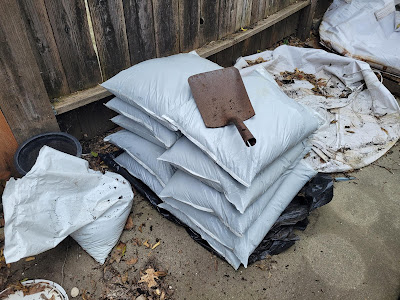What a year 2020 was - even for my backyard garden. Prior to winter setting in, I stocked up on leaves. When I say stocked up, I really mean it. 2019 was the year of leaves. I probably gathered at least 50 bags of leaves. I had so many leaves that I had leaves stored at the side of the house, waiting to be put into the compost. This year I decided to grow oats as a cover crop.
 |
The backyard garden later in the summer
|
 |
My compost in the side yard
|
 |
Robin Hood Fava and Oats
|
 |
The oats take over
|
Meanwhile,
the squirrels kept either digging up or eating my lettuce plants, no
matter what I did – so I eventually decided to grow my lettuce on our
upstairs balcony with aluminum foil around it. I’ll discuss the joys of
this experiment later. As the weather warmed, I brought out some banana
trees, which I nurtured in my greenhouse along with some trial cucumber
varieties. While growing out these varieties I also started my spring
transplants in 2 inch soil blocks in the greenhouse.
 |
Squirrel damage to lettuce. Only stumps remain.
|
 |
Doing what I can to grow lettuce.
|
 |
Clearing the garden for the summer crop
|
Over
time, the lettuce bolted and the summer cucumbers were put out. I grew a
round Carosello variety this year called Carosello Tondo Massafra. I
transplanted the bananas off to the side yard where I had previously
grown sweet potatoes and tomatoes. Unfortunately, due to further
squirrel damage (a child chose not to heed my request to not give the
squirrels nuts), I had to set out another round of Carosello Massafra
transplants. This really ate up my light hours and made my Massafra
harvest last through late July to early August.
 |
Growing the Carosello Massafra
|
As our new
neighbors were growing very tall corn, my August garden was really shaded my garden in the
afternoon. Unfortunately, powdery mildew was already starting to kick in
near the end of the season when I decided to transplant the long dark
Armenian cucumber - so it was only a matter of time before the plants
succumbed to its effects.
 |
Powdery Mildew on my Dark Armenian Cucumber
|
 |
Growing out Taxi Tomatoes and banana trees in early spring
|
 |
The corner plot later in the summer
|
Meanwhile,
in the small corner garden, I grew out my little banana trees and Taxi
tomatoes. Both the banana trees and the tomatoes suffered until I
applied some biologically-based bacterial fungicide on the plants. Then
they went from dying to thriving.
This whole time, I was also trying out
cucamelons. Not that I am a huge fan, but since a lot of people seem to
like them, I decided to try growing them out.
 |
My cucamelon vines
|
 |
A cucamelon
|
Around June, I put out sweet potato
sets out of my Dingess purple sweet potatoes which I later harvested
after Thanksgiving. In
the autumn of 2020, I was unable to harvest as many leaves, due to the
fact that they all comedown at once. We had a combination of high winds
and cold nights that brought all the leaves down. The neighborhood in
which the leaves fell called up the city and they were quickly removed
before I could gather very much, so I am glad that I had plenty of
leaves to compost from my 2019 leaf harvest.
 |
Harvesting some Purple Dingess sweet potatoes
|
 |
Another look at the harvest
|
As
for my winter garden, I decided it was finally time for a rest. I had tried
planting out some Bolero carrots, but the pressure from squirrels was
too great. Instead, I would compost my garden and focus on finishing the
cucamelon harvest and seed processing.
 |
trying out new things as I begin fallowing the garden
|
 |
Processing Cucamelon Seed
|



















































